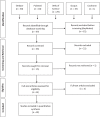Fat embolism syndrome in patients with bilateral femur fractures: a systematic review and case comparison
- PMID: 35949269
- PMCID: PMC9359015
- DOI: 10.1097/OI9.0000000000000187
Fat embolism syndrome in patients with bilateral femur fractures: a systematic review and case comparison
Abstract
Objectives: Fat embolism and fat embolism syndrome (FES) remain common complications following long bone fractures. Incidence is highest after bilateral femur fractures. We performed a systematic review of FES after bilateral femur fractures and present two cases.
Data sources: Systematic literature search of the Cochrane, EMBASE, MEDLINE, Scopus, and, Web of Science Library databases was performed in August 2021. Terms used including plural and alternate spellings: "fat embolism,""fat embolism syndrome,""fat embolus," and "bilateral femur fracture." Articles in German and English were considered. No time frame was applied.
Study selection: Original studies, case series and case reports on fat embolism after bilateral femur fracture were included. Insufficient documentation or patients with relevant previous heath conditions were excluded.
Data extraction: Abstracts were organized using EndNote X9 by Carivate. Three authors independently screened the abstracts; cross check of the extracted data was performed by the senior author.
Data synthesis: Scarcity of articles only allowed for a qualitative synthesis. Data was compared with our cases and situated within the scientific background.
Results: Ten articles were included for qualitative synthesis (n = 144 patients). The symptoms were inhomogeneous with neurological deficits being most prominent. Degree of displacement was high, when reported. Although the modes and timing of surgery varied, this appeared unrelated with outcome.
Conclusions: FES remains a relevant complication after bilateral femur fractures, despite damage control strategies and improved reaming techniques. Fracture displacement and reduction maneuvers might play a more substantial role in the formation than previously accredited.
Level of evidence: 4.
Keywords: bilateral femur fracture; fat embolism; fat embolism syndrome; femur fracture; long bone fracture; trauma.
Copyright © 2022 The Authors. Published by Wolters Kluwer Health, Inc. on behalf of the Orthopaedic Trauma Association.
Conflict of interest statement
The authors have no conflicts of interest to disclose.
Figures
References
-
- Blokhuis TJ, Pape HC, Frölke JP. Timing of definitive fixation of major long bone fractures: can fat embolism syndrome be prevented? Injury 2017;48 (Suppl 1):S3–S6. - PubMed
-
- Giannoudis PV, Pape HC, Cohen AP, et al. Review: systemic effects of femoral nailing: from Küntscher to the immune reactivity era. Clin Orthop Relat Res 2002;404:378–386. - PubMed
-
- Gurd AR. Fat embolism: an aid to diagnosis. J Bone Joint Surg Br 1970;52:732–737. - PubMed
-
- Gurd AR, Wilson RI. The fat embolism syndrome. J Bone Joint Surg Br 1974;56B:408–416. - PubMed
-
- Newbigin K, Souza CA, Torres C, et al. Fat embolism syndrome: state-of-the-art review focused on pulmonary imaging findings. Respir Med 2016;113:93–100. - PubMed
LinkOut - more resources
Full Text Sources
Research Materials
Miscellaneous

